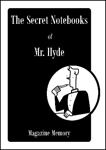Published on Sunday, February 22, 2009 in
books,
fun,
Knight's Tour,
Martin Gardner,
math,
puzzles,
software
 First, I taught the Knight's Tour. Next, I linked to Troyis. Now, there's a new Knight's move-based game out there!
First, I taught the Knight's Tour. Next, I linked to Troyis. Now, there's a new Knight's move-based game out there!
This game is called i-Yo-Re-Mo, an iPhone puzzle game that will also work in most browsers. The challenge is to switch the locations of red and green balls on any board. The only legal moves for the balls are the standard L-shaped Knight moves. There are 8 different puzzles, ranging from easy ones done in 4 moves, all the way up to the difficult ones that require 48 moves! These various boards are available by clicking the Menu button, and then clicking on Load board.
Try out the various challenges, including the 8-move easy game (available in the Load board section by clicking on the dot that's 2nd from the left). Once you've had a try on your own, come back here, and I'll tell you a little secret.
While this iPhone version of the game is new, the basic game is not. Martin Gardner wrote both about this general challenge and the 8-move easy version specifically, in his Mathematical Games column, and in his later books. These challenges may seem difficult, but there is a way to break the games down and make them much easier.
Let's start with that 8-move easy version. Were you able to solve it? Were you able to do it in 8 moves? Let's break down the problem to clarify it. First, let's name the upper left square as square 1. Where can we move from square 1? One of the places is the rightmost square in the middle row, so we'll call that square 2 (It could also travel to the centermost square in the bottom row, but we need to choose one or the other). Working through one possible path starting in the upper right, we get a board that looks like this:
147
6 2
385
If a knight is place on square 1, he could move around the squares as marked, in order from 1 to 8 (or from 2 to 1, 3 to 2, and so on, as well as 8 to 1, 7 to 8, 6 to 7, etc.). In the 8-move easy puzzle from i-Yo-Re-Mo, there are knights place on squares 1, 7, 3 and 5 - all odd numbered squares, interestingly. There's one more step to make this puzzle easier. Note that none of the knights can possible move to the centermost square in the middle row.
If you take these squares as they are numbered, and put them in order in a circle, and then place the knights on the odd-numbered squares, the solution becomes ridiculously easy! You realize that all you have to do is move each of the four knights in the same clockwise direction, in clockwise order (or in a counterclockwise direction in counterclockwise order) for the first 4 moves, and then move the knights again in that same direction and order for the remaining 4 moves!
Since this circular problem is isomorphic with i-Yo-Re-Mo's 8-move easy puzzle, you can use exactly the same moves to solve both puzzles.
In this excerpt from the free limited preview of Martin Gardner's book Aha! Insight/Gotcha, this approach is taken with boards other than 3 by 3, and that can greatly help when working out solutions for the other i-Yo-Re-Mo boards.
Once you've picked up the basic idea for puzzles knight's moves, try working out the same approach to the classic 7-penny puzzle!

 I'd like to ask for your opinions on a potential new feature I'm considering adding to the Mental Gym.
I'd like to ask for your opinions on a potential new feature I'm considering adding to the Mental Gym.

 First,
First,  It's time to update some of my older columns, and share some new treasures with you in the process!
It's time to update some of my older columns, and share some new treasures with you in the process!


 Congratulations to the Pittsburgh Steelers on their
Congratulations to the Pittsburgh Steelers on their 

